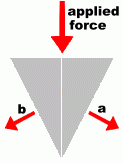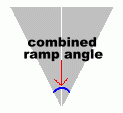  The wedge is a combination of two inclined planes, placed back to back, and is commonly used for splitting objects apart.
The wedge is a combination of two inclined planes, placed back to back, and is commonly used for splitting objects apart. The principle used is similar to inclined planes, in that the applied force can be less than the force needed to directly pull the object apart. But more importantly, the wedge uses the property of an inclined plane that causes the applied force to be sent in two directions. In this case, the part of the force that pushes outwards from the plane's surface is used; the fact that there are two planes, each sending out a force in a different direction, makes the wedge ideal for splitting materials. Any tool with a cutting edge has a wedge for a blade. Common examples are the axe, and cutting tools (which have two wedges at the end of levers, to further multiply the force).    Force multiplication works like this: a very sharp wedge will have a small ramp angle, and will apply a large sideways force. But you'll have to move it farther into the material to fully split it. Force multiplication works like this: a very sharp wedge will have a small ramp angle, and will apply a large sideways force. But you'll have to move it farther into the material to fully split it.Alternately, a wedge with a large ramp angle won't apply as much sideways force, but you won't have to move it as far throught the material. Since wood tends to split easily along the grain, it can be split most easily with a log-splitting axe that has a wide angle, providing just a small sideways force, and requiring little penetration into the wood. If you used a sharp thin axe, you would get more force, but have to bury the axe deeper into the wood to split it. A wedge can also be used as a lifting device, by forcing it under an object. |